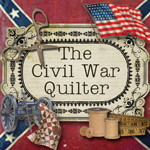Biedler Spinning Wheel
from the Biedler Covered Bridge Farm
of New Market Virginia
Anyone know if there was a published pattern at one time? Or do you think someone just created their own from a silhouette image?
(above) This is the only other spinning-wheel-focused quilt I have seen an image of seen.
The photo above is just one block from
a quilt in my collection
a quilt in my collection
by African American quilt artist Marie Wilson.
This is another Marie Wilson quilt I jut discovered in the April 1987 back issue of Quilters Newsletter magazine. Does anyone know where this quilt resides now?
Why did I buy the spinning wheel quilt (other than the fact that I love old quilts, period!) I bought it mainly because I inherited a family spinning wheel from the Shenandoah Valley before I left Virginia in 2004!
Below is my youngest grandson exploring the old family spinning wheel.
I am so grateful life took us to Virginia for 15 years, thus enabling me to do primary family research. I inherited this beautiful object from 101 year-old Mary Lucille Biedler Piner, a distant cousin. I discovered her brother Claude Daniel Biedler in Vienna, VA about 1991, which eventually led me to Lucille who lived in Shelby, NC at the time.
Just above is a photo of Luciile's grandparents, her grandfather being my Grandfather's uncle and her grandmother being the one who originally owned the spinning wheel and from whom Lucille inherited it. This branch of the Biedler family lived near New Market, VA and built the Biedler Covered Bridge in 1895, the last covered bridge in Virginia on private land (not owned by the state) that is still in daily use. Some of my research on this family was referenced in the book "The Covered Bridges of Virginia" by Leola B. Pierce.
Besides the spinning wheel, I also inherited 15 Farm Ledgers from Lucille about the building and working of the Biedler Covered Bridge Farm from the 1870-1960. The ledgers even list all the men hired to make the bricks right there on the farm and lists all the construction supplies Daniel ordered
from Baltimore.
One or two of the ledgers I have were kept by the women of the family. In those ledgers they recorded the money they made from the selling of their turkeys / chickens / and eggs. I was told that money was theirs to spend as they chose for they hard earned it. It is all great reading if you love studying cultural history.
BELOW: A spinning wheel I found on line that looks very similar to mine.
Here is another photo (below) I found with the parts of the spinning wheel identified and labeled.
You can read more about this family farm by clicking here and going to my Biedler blog.
So many more things to write about, but it is time to get back to a quilting deadline I have. I actually don't quilt very often. As much as I love it, I love research and writing even more so that is where I spend most of my time.
Hope you keep files of your own family history for future generations!
Happy Holidays!
Karen
Subscribe to: Post Comments (Atom)






























































NO COMMENTS: